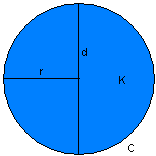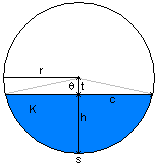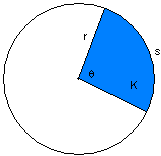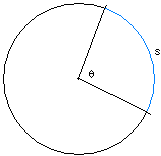Circle Equations Formulas Calculator
Math Geometry
Problem:

Solve for circle diameter.
Enter Calculator Inputs:
Can you share this page? Because, it could help others.
Solution:
Change Equation or Formulas:
Tap or click to solve for a different unknown or equation

| diameter | |
| radius |
| circumference | |
| radius |
| circumference | |
| diameter |
| circumference | |
| area |
| area | |
| radius |
| area | |
| diameter |
| area | |
| circumference | |
| radius |

| chord length | |
| circle radius | |
| circle center to chord midpoint distance |
| segment area | |
| circle radius |
| central angle | |
| arc length | |
| circle radius |
| segment height | |
| circle radius | |
| circle center to chord midpoint distance |

| sector area | |
| circle radius | |
| central angle |

| arc length | |
| circle radius | |
| central angle |
Background
A circle is a fundamental geometric shape consisting of points equidistant from a fixed central point, known as the radius (r). The diameter (d) spans the circle, stretching through the center with its endpoints on its perimeter. Understanding how radius and diameter are related is essential in geometry and has many scientific and practical uses.
Equation
The formula for finding the diameter of a circle from its radius is simple:
d = 2r
This equation specifies that the diameter (d) is twice the radius (r). This relationship remains the same in all circles, regardless of their size.
How to Solve
Calculating the diameter when the radius is known involves a simple multiplication:
- Start with the formula: Begin with the equation d = 2r.
- Enter the radius value: Input the radius value where (r) is in the formula.
- Multiply: Multiply the given radius by 2.
- Find the diameter: The product is the circle's diameter.
Example
A circle has a 4-inch radius. To find the diameter:
d = 2r
Insert the known radius:
d = 2 x 4 inches
Thus, the circle's diameter is:
d = 8 inches
Fields/Degrees It Is Used In
- Mechanical Engineering: Designing components with rotational symmetry, such as wheels, pulleys, and bearings, is essential.
- Medicine: This technology is helpful in medical imaging because it is crucial to understand the size of circular objects like tumors for planning treatments.
- Astronomy: Employed while measuring and understanding celestial objects and their movements within the cosmos.
- Urban Planning: Designing curved roadways, rotundas, and roundabouts ensures smooth traffic flow.
- Computer Graphics: Integral to algorithm development that involves rendering circular objects and arcs in digital imagery.
Common Mistakes
- Mixing Radius and Diameter: Using the wrong diameter or radius can lead to accurate results.
- Incorrect Measurements: Failing to measure the radius accurately from the exact center to the perimeter can lead to wrong outcomes.
- Formula Confusion: Misapplying the formula meant for circumference or area while trying to find the diameter.
- Miscalculations: Simple arithmetic errors during multiplication can yield incorrect diameters.
- Neglecting Units: Different or incoherent use of units (e.g., mixing centimeters with inches) can disrupt the equation's balance.
Frequently Asked Questions
- Can the diameter be smaller than the radius? No, the diameter is always twice the radius; hence, it is always larger or equal (in hypothetical zero radius cases).
- What happens if I measure the diameter but need the radius? Divide the diameter by 2 to get the radius.
- Is the formula different if the circle's diameter crosses it multiple times? No, regardless of position, the formula (d = 2r) always applies as it is derived from the geometric properties of a circle.
- How can I ensure accurate radius measurement in a practical scenario? It's important to use accurate measuring tools, such as a caliper, to measure the circumference of a circle from different points to the center and calculate the average measurement, if possible.
- Does this formula work for ellipses or other round shapes? The formula only applies to perfect circles, not ellipses, with different measurements and requiring different calculations.
Online Web Apps, Rich Internet Application, Technical Tools, Specifications, How to Guides, Training, Applications, Examples, Tutorials, Reviews, Answers, Test Review Resources, Analysis, Homework Solutions, Worksheets, Help, Data and Information for Engineers, Technicians, Teachers, Tutors, Researchers, K-12 Education, College and High School Students, Science Fair Projects and Scientists
By Jimmy Raymond
![]()
Contact: aj@ajdesigner.com
Privacy Policy, Disclaimer and Terms
Copyright 2002-2015